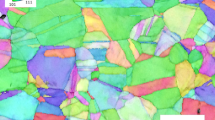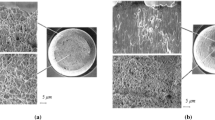Abstract
In a dynamic experiment to obtain the high-rate stress–strain response of a ductile specimen, it takes a finite amount of time for the strain rate in the specimen to increase from zero to a desired level. The strain in the specimen accumulates during this strain-rate ramping time. If the desired strain rate is high, the specimen may yield before the desired rate is attained. In this case, the strain rates at yielding and early plastic flow are lower than the desired value, leading to inaccurate determination of the yield strength. Through experimentation and analysis, we examined the validity and accuracy of the flow stresses for ductile materials in a split Hopkinson pressure (SHPB) bar experiment. The upper strain-rate limit for determining the dynamic yield strength of ductile materials with a SHPB is identified.










Similar content being viewed by others
References
Zukas JA, Nicholas T, Swift HF, Greszczuk LB, Curran DR (1992) Impact dynamics. Krieger, Malabar, FL.
Rajendran AM, Bless SJ, Dawicke DS (1986) Evaluation of Bodner-Partom model parameters at high-strain rate. Exp Mech 26:319–323.
Liang R, Khan AS (1999) A critical review of experimental results and constitutive models for BCC and FCC metals over a wide range of strain rates and temperatures. Int J Plast 15:963–980.
Khan AS, Zhang H (2000) Mechanically alloyed nanocrystalline iron and copper mixture: behavior and constitutive modeling over a wide range of strain rates. Int J Plast 16:1477–1492.
Lindholm US (1964) Some experiments with the split Hopkinson pressure bar. J Mech Phys Solids 12:317–335.
Rajendran AM, Garrett RK, Clark JB Jr, Jungling TL (1991) Effects of strain rate on plastic flow and fracture in pure tantalum. J Mater Shap Technol 9:7–20.
Warren TL, Forrestal MJ (1998) Effects of strain hardening and strain-rate sensitivity on the penetration of aluminum targets with spherical-nosed rods. Int J Impact Eng 35:3737–3753.
Rittel D, Ravichandran G, Lee S (2002) Large strain constitutive behavior of OFHC copper over a wide range of strain rates using the shear compression specimen. Mech Mater 34:627–642.
Krempl E, Khan F (2003) Rate (time)-dependent deformation behavior: an overview of some properties of metals and solid polymers. Int J Plast 19:1069–1095.
Khan AS, Suh YS, Kazmi R (2004) Quasi-static and dynamic loading responses and constitutive modeling of titanium alloys. Int J Plast 20:2233–2248.
Frew DJ, Forrestal MJ, Chen W (2002) Pulse shaping techniques for testing brittle materials with a split Hopkinson pressure bar. Exp Mech 42:93–106.
Frew DJ, Forrestal MJ, Chen W (2005) Pulse shaping techniques for testing elastic-plastic materials with a split Hopkinson pressure bar. Exp Mech 45:186–195.
Duffy J, Campbell JD, Hawley RH (1971) On the use of a torsional split Hopkinson bar to study rate effects in 1100-0 aluminum (ASME Transactions). J Appl Mech 37:83–91.
Chen W, Song B, Frew DJ, Forrestal MJ (2003) Dynamic small strain measurements of a metal specimen with a split Hopkinson pressure bar. Exp Mech 43:20–23.
Meyers MA (1994) Dynamic behavior of materials. Wiley, New York.
Gray G (2000) Classic split-Hopkinson pressure bar testing. In: Mechanical testing and evaluation, ASM handbook. ASM, Materials Park, OH, pp 462–476.
Ellwood S, Griffiths LJ, Parry DJ (1982) Materials testing at high constant strain rates. J Phys E Sci Instrum 15:280–282.
Leroy M, Raad MK, Nkule L, Cheron R (1984) Influence of instantaneous dynamic decremental/incremental strain rate tests on the mechanical behavior of metals—application to high-purity polycrystalline aluminum. In: 3rd conference of mechanical properties at high rates of strain 70, pp 31–38.
Kobayashi H, Daimaruya M, Nojima T, Kajino T (2000) Effect of strain rate change during uniaxial dynamic tensile tests on instability strain. J Phys IV (France) 10:Pr9-433–438.
Nojima T, Ogawa K (1985) New applications of split Hopkinson bar to materials testing. J Phys Colloq C5:623–631.
Song B, Chen W, Weerasooriya T (2003) Quasi-static and dynamic compressive behaviors of a S-2 glass/SC15 composite. J Compos Mater 37:1723–1743.
Song B, Chen W (2004) Loading and unloading SHPB pulse shaping techniques for dynamic hysteretic loops. Exp Mech 44:622–627.
Pan Y, Chen W, Song B (2005) The upper limit of constant strain rate in a split Hopkinson pressure bar experiment. Exp Mech 45:440–446.
Song B, Chen WW, Dou S, Winfree NA, Kang JH (2005) Strain-rate effects on elastic and early cell-collapse responses of a polystyrene foam. Int J Impact Eng 31:509–521.
Ramesh KT, Narasimhan S (1996) Finite deformations and the dynamic measurement of radial strains in compression Kolsky bar experiments. Int J Solids Struct 33:3723–3738.
Jia D, Ramesh KT (2004) A rigorous assessment of the benefits of miniaturization in the Kolsky bar system. Exp Mech 44:445–454.
Gilat A, Cheng CS (2002) Modeling torsional split Hopkinson bar tests at strain rates above 10,000 s−1. Int J Plast 18:787–799.
Acknowledgments
This work was supported by Sandia National Laboratories, Albuquerque, NM and Livermore, CA. Sandia is a multiprogram laboratory operated by Sandia Corporation, a Lockheed Martin Company, for the United States Department of Energy under Contract DE-AC04-94AL8500.
Author information
Authors and Affiliations
Corresponding author
Rights and permissions
About this article
Cite this article
Song, B., Chen, W., Antoun, B.R. et al. Determination of Early Flow Stress for Ductile Specimens at High Strain Rates by Using a SHPB. Exp Mech 47, 671–679 (2007). https://doi.org/10.1007/s11340-007-9048-6
Received:
Accepted:
Published:
Issue Date:
DOI: https://doi.org/10.1007/s11340-007-9048-6




